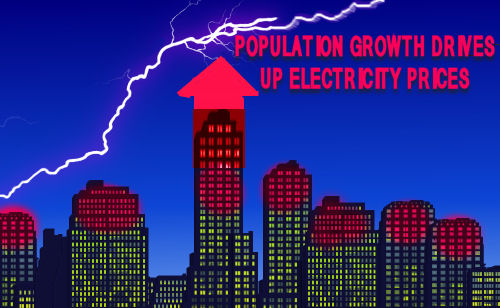Population growth drives electricity prices up - Kelvin Thomson
 Kelvin Thomson MP: "It seems to me that a key driver of rising electricity prices that doesn’t get much attention in the electricity prices debate is population growth. This growth was driving electricity prices up at twice the rate of CPI long before the carbon price ever showed up. I did a detailed speech in Parliament in late 2010 about this issue, which pointed out that electricity prices in Sydney and Melbourne had doubled in the previous decade, which was twice the rate of CPI."
Kelvin Thomson MP: "It seems to me that a key driver of rising electricity prices that doesn’t get much attention in the electricity prices debate is population growth. This growth was driving electricity prices up at twice the rate of CPI long before the carbon price ever showed up. I did a detailed speech in Parliament in late 2010 about this issue, which pointed out that electricity prices in Sydney and Melbourne had doubled in the previous decade, which was twice the rate of CPI."

Population a key driver of Electricity Prices
[Originally published at http://kelvinthomson.blogspot.com.au/2012/12/electricity-prices.html Headings are by candobetter.net editor]
It seems to me that a key driver of rising electricity prices that doesn’t get much attention in the electricity prices debate is population growth. This growth was driving electricity prices up at twice the rate of CPI long before the carbon price ever showed up. I did a detailed speech in Parliament in late 2010 about this issue, which pointed out that electricity prices in Sydney and Melbourne had doubled in the previous decade, which was twice the rate of CPI.
Poor understanding of impact of population growth on infrastructure among policy makers
The impact of population growth on the cost of infrastructure isn’t well understood, not even by policy makers. If the average life of the nation’s infrastructure is 50 years, then you’ve got to set aside 2% of the nation’s income every year to keep replacing it and deal with it wearing out. But if your population is increasing by 2% a year then the new people need 100% extra infrastructure for their needs, so you’ve got to set aside another 2% of the nation’s income for that, that is, twice as much as with a stable population.
A 2% population increase only gets you 2% extra income, but it doubles your infrastructure spend. That’s why electricity, gas, water, council rates all keep rising higher than inflation. I don’t think it’s fair that pensioners and ordinary consumers should have to pay for this. I think that it’s the beneficiaries of population growth who should pay for the costs of it. The principal beneficiaries are the property developers whose land values rise when population rises.
Classic example where developers should pay to change zones
A classic example was reported in Melbourne a couple of days ago of property developers wanting to build 30 storey high-rise buildings at Fisherman’s Bend. These developments inevitably require more electricity infrastructure – I don’t think pensioners in my electorate and other inner city residents should have to pay for that. I think that when they put in an application for rezoning or planning permits that mean more people are going to live on the site, there should be a financial contribution that genuinely reflects the extra infrastructure costs that come with that population growth. The mechanism for that needs to be worked out between governments, electricity companies and Councils, but the principle should be that the beneficiaries of population growth pay for the extra infrastructure costs that come with it.

Recent comments